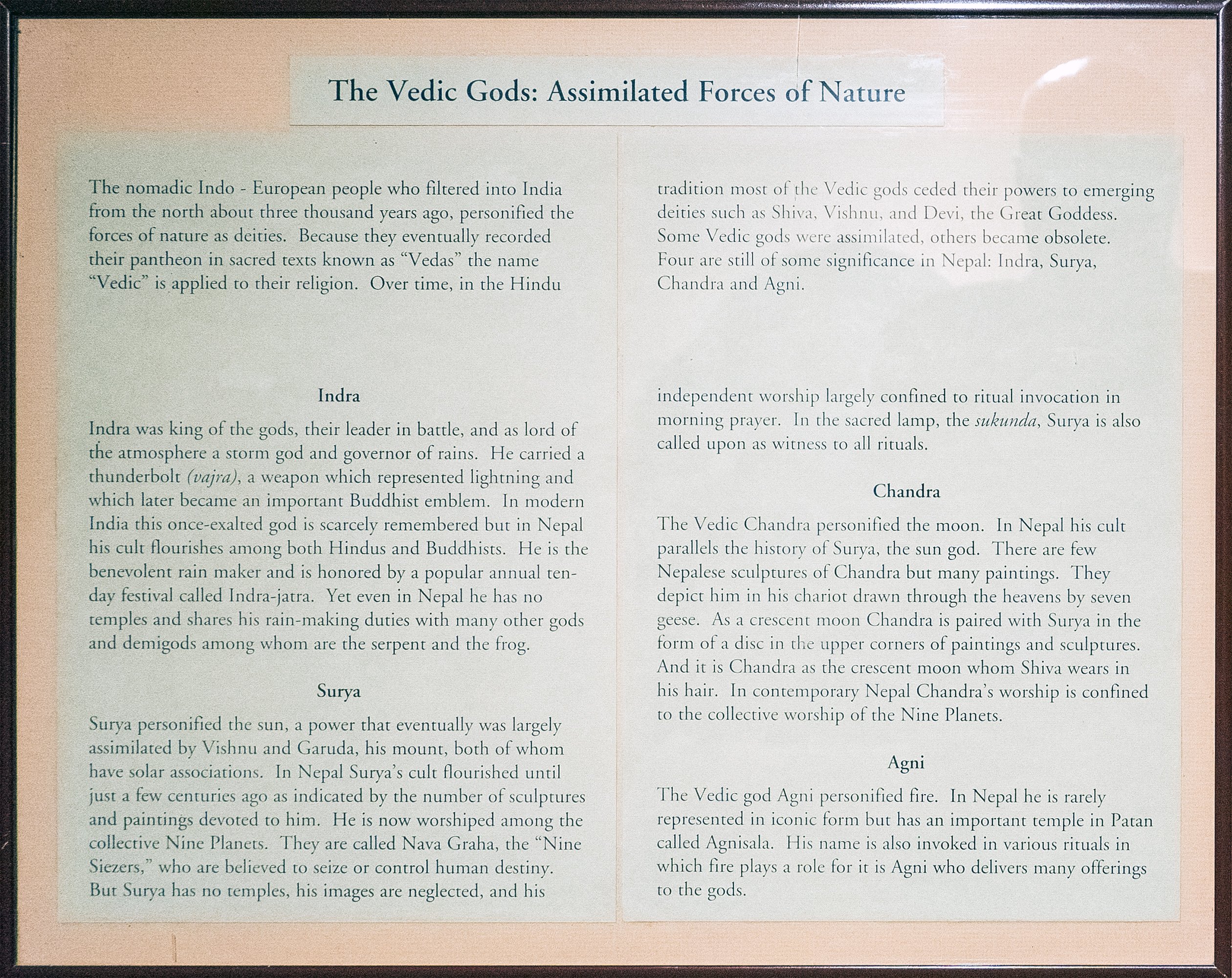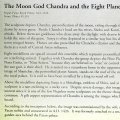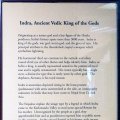Patan Museum (Nepal): photo 179
Photo 179 of 212 in Gallery: Patan Museum (Nepal)

Image title: The Vedic Gods: Assimilated Forces of Nature
Description of the photo
The Vedic Gods: Assimilated Forces of Nature—The nomadic Indo-European people who filtered into India from the north about three thousand years ago, personified the forces of nature as deities. Because they eventually recorded their pantheon in sacred texts known as “Vedas” the name “Vedic” is applied to their religion. Over time, in the Hindu tradition most of the Vedic gods ceded their powers to emerging deities such as Shiva, Vishnu, and Devi, the Great Goddess. Some Vedic gods were assimilated, others became obsolete. Four are still of some significance in Nepal: Indra, Surya, Chandra and Agni.
Indra
Indra was king of the gods, their leader in battle, and as lord of the atmosphere a storm god and governor of rains. He carried a thunderbolt (vajra), a weapon which represented lightning and which later became an important Buddhist emblem. In modern India this once-exalted god is scarcely remembered but in Nepal his cult flourishes among both Hindus and Buddhists. He is the benevolent rain maker and is honored by a popular annual ten-day festival called Indra-jatra [Indra-yatra]. Yet even in Nepal he has no temples and shares his rain-making duties with many other gods and demigods among whom are the serpent and the frog.
Surya
Surya personified the sun, a power that eventually was largely assimilated by Vishnu and Garuda, his mount, both of whom have solar associations. In Nepal Surya’s cult flourished until just a few centuries ago as indicated by the number of sculptures and paintings devoted to him. He is now worshiped among the collective Nine Planets. They are called Nava Graha, the “Nine Seizers,” who are believed to seize or control human destiny. But Surya has no temples, his images are neglected, and his independent worship largely confined to ritual invocation in morning prayer. In the sacred lamp, the sukunda, Surya is also called upon as witness to all rituals.
Chandra
The Vedic Chandra personified the moon. In Nepal his cult parallels the history of Surya, the sun god. There are few Nepalese sculptures of Chandra but many paintings. They depict him in his chariot drawn through the heavens by seven geese. As a crescent moon Chandra is paired with Surya in the form of a disc in the upper corners of paintings and sculptures. And it is Chandra as the crescent moon whom Shiva wears in his hair. In contemporary Nepal Chandra’s worship is confined to the collective worship of the Nine Planets.
Agni
The Vedic god Agni personified fire. In Nepal he is rarely represented in iconic form but has an important temple in Patan called Agnisala. His name is also invoked in various rituals in which fire plays a role for it is Agni who delivers many offerings to the gods.
Gallery information:
The Patan Museum is located on the Durbar square of Patan (Lalitpur/Lalitapura, Kathmandu, Nepal) which is associated Keshav Narayan Chowk (Keshavnarayan)—a form of Lord Vishnu. Being listed as a World Heritage Site, the whole of Durbar square is filled with exquisite temples, sculptures and other ancient structures, of which the ancient history history can be traced to the Malla Kings of Lalitpur. It is an important site for both Buddhism and Hinduism.
Photo details:
Date: 2019-12-02
Camera: SONY ILCE-6400
Exposure: 1/160
Aperture: f/4
ISO: 1600
Focal length: 18mm
High resolution:
Download file
Size: 2.74 MB
Resolution: 2520 x 2000
© Photograph by Gabe Hiemstra.
License: CC BY-NC-ND 4.0

